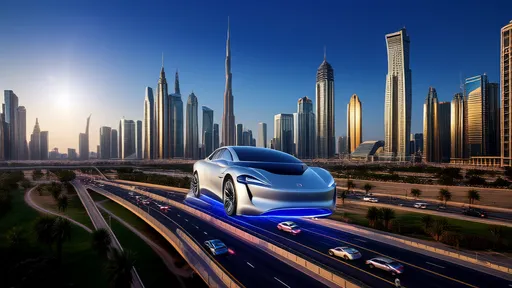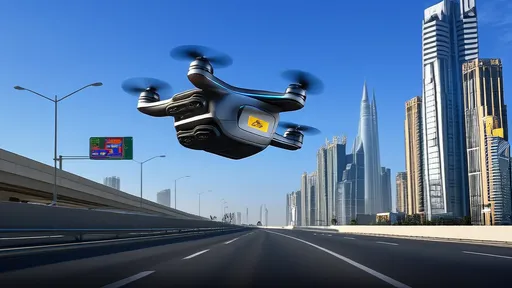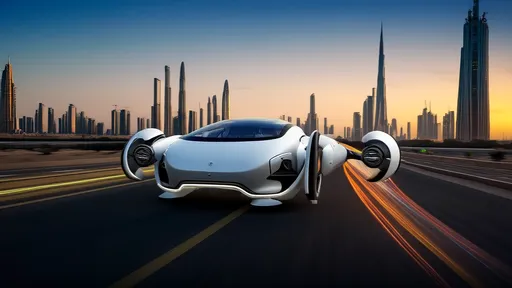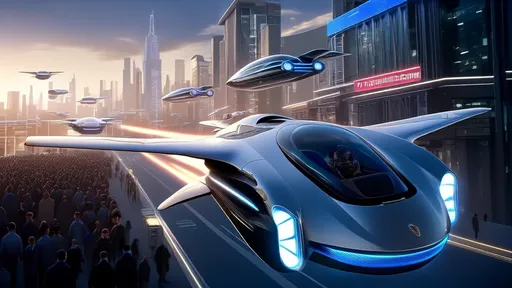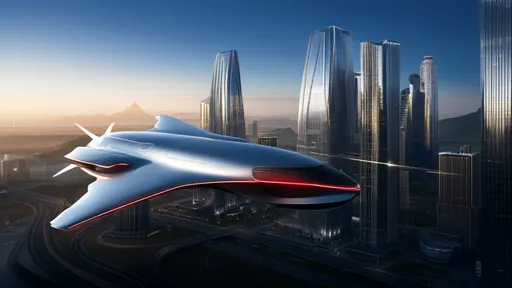The desert skies above Dubai witnessed a historic moment last week as the sleek silhouette of a flying car cut through the cerulean blue, marking what many industry experts are calling the dawn of a new era in personal transportation. The demonstration, orchestrated by the pioneering aviation firm AeroMobil Emirates, was not merely a test flight; it was a powerful statement of intent, a tangible promise of a future once confined to the pages of science fiction.
Against the backdrop of the city's iconic skyline, the vehicle, dubbed the "SkyRukh," performed a series of graceful maneuvers. It began its journey on a designated runway, accelerating like a conventional sports car before its wings unfolded in a seamless, automated ballet. With a low hum from its advanced electric propulsion system, it lifted vertically into the air, transitioning smoothly from terrestrial vehicle to aircraft. The entire transformation, from road-ready to airborne, took less than sixty seconds, a feat that drew audible gasps from the assembled dignitaries, investors, and media.
The successful demonstration is the culmination of nearly a decade of clandestine research and development, heavily backed by the UAE's strategic investment funds. It represents a significant leap forward in overcoming the core technical challenges that have long plagued the concept of flying cars: noise pollution, energy efficiency, and, most critically, safety. The SkyRukh utilizes a distributed electric propulsion system with multiple redundant rotors, ensuring that the failure of one or even two components would not lead to a catastrophic loss of control. Its onboard artificial intelligence handles the complexities of stability and navigation, requiring only broad destination input from the pilot.
Sheikh Ahmed al-Mansoori, a key figure in the UAE's technology diversification efforts, addressed the crowd after the flight. "Today, we are not just launching a vehicle; we are launching a new dimension of freedom," he declared, his voice resonating with conviction. "The skies have always been the final frontier for personal mobility. For decades, we have been stuck in two dimensions, our journeys dictated by the winding paths of roads. The SkyRukh shatters those constraints. This is about redefining how we live, work, and connect our cities." His speech underscored a national vision that extends far beyond mere technological achievement, aiming to position the UAE as the global hub for the Advanced Air Mobility (AAM) industry.
The implications for a nation like the UAE, with its sprawling urban centers and significant travel distances between major cities, are profound. A commute from downtown Dubai to the heart of Abu Dhabi, which can often take over ninety minutes by car, could be reduced to a swift twenty-minute flight. This has the potential to radically alter urban planning, reduce the immense pressure on road infrastructure, and unlock new economic opportunities by effectively shrinking the country's geographic footprint. Real estate in previously considered remote areas could surge in value as the concept of a 'reasonable commute' is completely redefined.
However, the path to a sky filled with personal flying vehicles is fraught with hurdles that extend beyond engineering. The most significant challenge lies in the realm of regulation and airspace management. Current aviation laws are built around the paradigms of commercial airlines, helicopters, and general aviation, not a potential fleet of thousands of personal eVTOLs (electric Vertical Take-Off and Landing aircraft). Creating a robust, automated traffic management system for low-altitude urban airspace, often referred to as a "sky highway" system, is a monumental task. It requires the development of new protocols for collision avoidance, communication, and routing to prevent chaos in the skies.
Public acceptance is another critical frontier. The persistent noise of helicopters has often led to public opposition to urban air travel. AeroMobil Emirates has invested heavily in acoustic engineering, and the SkyRukh was noticeably quieter than a traditional helicopter, but the cumulative effect of hundreds of such vehicles remains a subject of study. Furthermore, convincing the general public of the inherent safety of autonomous or semi-autonomous flight, especially in densely populated areas, will require a sustained campaign of transparency, education, and demonstrably flawless safety records over time.
Economically, the initial cost of such technology will be prohibitively high, placing it firmly in the domain of the wealthy and corporate entities. Early adoption is likely to be seen in premium ride-sharing services, emergency medical services, and inter-city executive travel. The vision of every household owning a flying car remains a distant one. The ecosystem required—including "vertiports" for takeoff and landing, specialized maintenance facilities, and a new breed of certified pilots and mechanics—will take years, if not decades, to build at a scale that supports mass adoption.
Despite these challenges, the demonstration in Dubai has sent a clear and unambiguous signal to the world. The race for the skies is no longer a theoretical exercise; it is a commercial and technological reality that is accelerating. Other major players, from legacy automotive giants in Germany and Japan to Silicon Valley tech behemoths, are known to have their own advanced prototypes in development. The UAE, with its bold vision, favorable regulatory environment, and immense financial resources, has now positioned itself at the very forefront of this nascent industry.
The flight of the SkyRukh is more than a successful test. It is a catalyst. It forces governments worldwide to seriously contemplate their own air mobility strategies. It pushes competitors to accelerate their timelines. And, perhaps most importantly, it captures the public imagination, making the fantastical seem increasingly plausible. The era of personal flight is no longer a question of 'if,' but of 'when.' And as the desert sands settle back onto the Dubai tarmac, the world is left looking up, wondering just how soon the sky will become the next great frontier for our daily commute.
The once-fantastical vision of humanoid robots, long confined to the pages of science fiction and the silver screen, is steadily materializing into a tangible engineering reality. This evolution is not the result of a single, monumental breakthrough but rather a profound and intricate symphony of advancements across a multitude of scientific and engineering disciplines. The quest to create machines that not only look but also move, perceive, and interact with the fluidity and adaptability of humans represents one of the most ambitious technological endeavors of our time. It is a grand convergence, where progress in artificial intelligence, materials science, mechanical engineering, and cognitive science coalesces to breathe life into metal and silicon, pushing the boundaries of biomimicry to unprecedented heights.
The recent inclusion of humanoid robots in the 2025 Top Ten Global Engineering Achievements marks a watershed moment in technological history. This recognition transcends mere academic acknowledgment; it represents a collective global validation of decades of research, development, and iterative innovation in robotics. For years, humanoid robots existed primarily in the realms of science fiction and laboratory prototypes, often viewed as fascinating but distant curiosities. Their elevation to a top global engineering feat signals a profound shift—a transition from conceptual marvels to tangible agents of change poised to reshape our societal and industrial landscapes.
In a landmark recognition of human engineering prowess, China's full-ocean-depth manned submersible has been selected among the 2025 Top Ten Global Engineering Achievements, standing shoulder-to-shoulder with revolutionary projects like quantum computing infrastructure and Mars colonization prototypes. This prestigious listing, announced by the International Engineering Consortium earlier this morning, represents more than just technological acknowledgment—it signifies humanity's renewed commitment to conquering Earth's final frontier.
In the heart of Dubai's morning rush hour, the familiar gridlock of Sheikh Zayed Road stretches for kilometers below, but above the shimmering asphalt, a new dimension of transportation is quietly rewriting the rules of urban mobility. As first reported by The Times of India, the city's ambitious flying car initiative has transitioned from futuristic concept to operational reality, with commuters now gliding between skyscrapers in electric vertical take-off and landing vehicles. This isn't a scene from a science fiction film but the new daily reality for a growing number of Dubai residents who have traded their terrestrial commutes for the freedom of three-dimensional travel.
The desert skies of the United Arab Emirates, long dominated by the sleek silhouettes of commercial airliners and private jets, are poised to welcome a new kind of vessel. In a landmark decision that signals a significant leap from science fiction to tangible reality, a specific model of flying car has been granted a special certificate of flight from the UAE's civil aviation authority. This is not merely a provisional test permit for a closed course; it is a crucial regulatory nod that brings the vision of urban air mobility one giant step closer to the daily lives of the region's residents.
In a move signaling a new era of technological collaboration, Southeast Asian nations and the United States are forging a groundbreaking partnership in artificial intelligence development. This strategic alliance emerges at a critical juncture when global AI governance remains fragmented and the technology's potential to reshape economies and societies becomes increasingly apparent. The collaboration represents more than just technical cooperation—it embodies a shared vision for responsible innovation that respects cultural diversity while addressing common challenges.
The Euclid Space Telescope, humanity's newest and most ambitious eye on the cosmos, has begun its monumental mission to pierce the profound darkness that envelops our universe. Launched into the silence beyond our atmosphere, its purpose is not merely to capture stunning celestial portraits but to map the invisible architecture of reality itself. For decades, astronomers have known that the cosmos we see—the glittering tapestry of stars, galaxies, and nebulae—comprises a mere five percent of the total content of the universe. The remaining ninety-five percent is a profound mystery, a dual enigma composed of dark matter and dark energy. These are the phantoms of physics, entities that do not emit, absorb, or reflect light, yet whose gravitational influence dictates the fate of everything we hold visible. Euclid is our most sophisticated attempt to date to bring these shadows into the light, to understand the hidden forces that have shaped the universe's past and will determine its ultimate destiny.
Beijing's National Stadium, once the iconic centerpiece of the 2008 Summer Olympics, echoed with a different kind of applause this week. The thunderous cheers were not for human athletes pushing the limits of physical endurance, but for their mechanical counterparts—humanoid robots competing in the inaugural World Humanoid Robot Sports Games. The air, thick with the whirring of servos and the collective anticipation of engineers and spectators, marked a pivotal moment in the history of robotics and international sport.
The landscape of oncology treatment is undergoing a profound transformation, driven by the emergence of third-generation antibody-drug conjugates (ADCs). These sophisticated therapeutic agents represent a significant leap forward in the quest for precision medicine, offering new hope for patients battling various forms of cancer. Unlike conventional chemotherapy that attacks both healthy and cancerous cells indiscriminately, these advanced biologics deliver potent cytotoxic agents directly to tumor cells, minimizing damage to healthy tissues and reducing debilitating side effects.
In the relentless battle against cancer, a revolutionary class of therapeutics has emerged, earning the evocative moniker of "precision missiles" for their ability to deliver potent cytotoxic agents directly to malignant cells while sparing healthy tissue. These are Antibody-Drug Conjugates, or ADCs, and they represent a sophisticated fusion of biologic targeting and potent chemotherapy, a paradigm shift in oncology that is redefining treatment expectations for a growing number of cancers.
The desert skies above Dubai witnessed a historic moment last week as the sleek silhouette of a flying car cut through the cerulean blue, marking what many industry experts are calling the dawn of a new era in personal transportation. The demonstration, orchestrated by the pioneering aviation firm AeroMobil Emirates, was not merely a test flight; it was a powerful statement of intent, a tangible promise of a future once confined to the pages of science fiction.
In a remarkable demonstration of growing consumer confidence in aerial mobility solutions, global pre-orders for flying cars have surged past the 7,000-unit milestone. This significant threshold, reached far earlier than most industry analysts had projected, signals a fundamental shift in public perception about the viability of personal air transportation. What was once confined to science fiction novels and futuristic concept videos is rapidly transforming into a tangible consumer product category with demonstrated market demand.
In the shimmering heat of the Arabian Gulf, a new silhouette is beginning to pierce the horizon. It is not the familiar form of a commercial airliner nor the sleek profile of a private jet, but something altogether more futuristic—a flying car. This vision, once confined to the realms of science fiction, is fast becoming a tangible reality, and it is Chinese innovation that is poised to turn the skies above Dubai, Abu Dhabi, and Riyadh into a dazzling new theater of urban mobility.
The relentless march of artificial intelligence demands computational power on a scale previously unimaginable. At the heart of this revolution lies the Graphics Processing Unit, or GPU, which has evolved from a specialized graphics rendering component into the primary engine for AI workloads. The latest generation of GPU architectures represents a paradigm shift, not merely an incremental improvement. These new designs are fundamentally re-engineering the silicon to tackle the unique and colossal demands of modern AI, with a core focus on achieving unprecedented levels of computational density and efficiency through hyper-scale integration.
The ASEAN-US AI Cooperation Forum concluded its third annual session this week with a renewed commitment to bridging the digital divide through focused capacity building and infrastructure development. Held against the backdrop of rapid technological advancement, the forum brought together policymakers, industry leaders, and academics to chart a collaborative path forward, recognizing that the benefits of artificial intelligence must be distributed equitably to ensure regional stability and prosperity.



